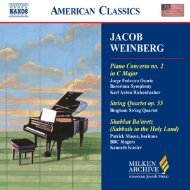Download Liner Notes PDF - Milken Archive of Jewish Music
Download Liner Notes PDF - Milken Archive of Jewish Music
Download Liner Notes PDF - Milken Archive of Jewish Music
Create successful ePaper yourself
Turn your PDF publications into a flip-book with our unique Google optimized e-Paper software.
however, Milhaud was considered a revolutionary and<br />
an enfant terrible <strong>of</strong> the music world. Yet his actual<br />
approach owed more to the French composer Charles<br />
Koechlin than to Satie, and it built upon a particular<br />
concept <strong>of</strong> polytonality derived from Stravinsky’s early<br />
ballets. Ultimately Milhaud believed not in revolution,<br />
but in the development and extension <strong>of</strong> tradition.<br />
“Every work is not more than a link in a chain,” he<br />
postulated, “and new ideas or techniques only add to<br />
a complete past, a musical culture, without which no<br />
invention has any validity.”<br />
Milhaud’s personal Judaism as well as his family<br />
heritage informed a substantial number <strong>of</strong> his<br />
compositions, beginning with his Poèmes Juifs (1916)<br />
and followed by several prewar pieces with overt<br />
<strong>Jewish</strong> titles and content. But it was in his later <strong>Jewish</strong><br />
works that he relied frequently and specifically on<br />
the Provençal liturgical tradition that he knew from<br />
his youth in Aix-en-Provence. His Judaically related<br />
works from the period following his immigration<br />
to America include Cain and Abel, for narrator,<br />
organ, and orchestra; Candélabre à sept branches;<br />
David, an opera written for the Israel Festival; Saul<br />
(incidental music); Trois psaumes de David; Cantate<br />
de Job; Cantate de psaumes; and—arguably his most<br />
significant Judaic work—Service Sacré, an oratoriolike<br />
full-length Sabbath morning service (with<br />
supplemental settings for Friday evening) for cantor,<br />
rabbinical speaker, large chorus, and symphony<br />
orchestra, which was commissioned in 1947 and<br />
premiered by Temple Emanu-El in San Francisco.<br />
This service was first recorded in its entirety by the<br />
<strong>Milken</strong> <strong>Archive</strong> in 2000. His final work, Ani maamin<br />
(subtitled un chant perdu et retrouvé), on a text by<br />
Elie Wiesel, received its premiere in 1975 at Carnegie<br />
Hall, conducted by Lukas Foss, with soprano Roberta<br />
Peters, the Brooklyn Philharmonic, and several<br />
narrators, including Wiesel.<br />
ÉTUDES sur des thèmes liturgiques du<br />
Comtat Venaissin pour quatuor à cordes<br />
In the early 1970s Milhaud was approached about<br />
a commission by the Braemer Foundation <strong>of</strong><br />
Philadelphia. That local foundation had, in conjunction<br />
with Congregation Adath Jeshurun in Elkins Park<br />
(a Philadelphia suburb), previously sponsored<br />
competitions with monetary awards for what it called<br />
“Hebraic string quartets”—which it defined as works<br />
demonstrably based on established <strong>Jewish</strong> liturgical<br />
music traditions. After two composers, Nachum<br />
Amir and Yehuda Ben Cohen, had each received this<br />
award, the foundation reoriented its direction from<br />
competitions toward the commissioning <strong>of</strong> new works<br />
by well-known composers, and it turned first to Milhaud.<br />
The guidelines remained the same: the piece was to<br />
draw directly and identifiably on musical material that<br />
had been documented in one or more reliable notated<br />
musicological source. And the composer’s intent must<br />
be to create a “<strong>Jewish</strong> work.” However, according to<br />
Milhaud’s widow in her recollections thirty years later,<br />
the foundation was even more specific in Milhaud’s<br />
case, in view <strong>of</strong> his known Provençal <strong>Jewish</strong> heritage.<br />
He was asked expressly to incorporate in his quartet<br />
melodies <strong>of</strong> the Provençal rite—the liturgical tradition<br />
also known as minhag Carpentras—ins<strong>of</strong>ar as possible<br />
from his youthful memories <strong>of</strong> family celebrations and<br />
services at the synagogue in Aix-en-Provence.<br />
Minhag Carpentras (the custom <strong>of</strong> Carpentras) so<br />
named after one <strong>of</strong> the four cities where it once<br />
flourished, was the distinct liturgical tradition <strong>of</strong> the<br />
Jews <strong>of</strong> the Comtat Venaissin—a secluded region <strong>of</strong><br />
Provence where Jews lived, until the Revolution, within<br />
the domains and under the protection <strong>of</strong> the Church.<br />
In addition to Carpentras, the four communities <strong>of</strong> the<br />
Comtat included Cavaillon, Avignon, and L’Isle-sur la<br />
Sorgue. The Jews who were native to that region as<br />
8.559451
















